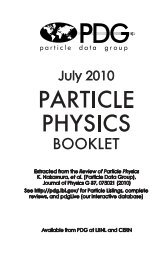30. Passage of particles through matter 1 - Particle Data Group
30. Passage of particles through matter 1 - Particle Data Group
30. Passage of particles through matter 1 - Particle Data Group
Create successful ePaper yourself
Turn your PDF publications into a flip-book with our unique Google optimized e-Paper software.
10 <strong>30.</strong> <strong>Passage</strong> <strong>of</strong> <strong>particles</strong> <strong>through</strong> <strong>matter</strong><br />
<strong>30.</strong>2.4. Density effect : As the particle energy increases, its electric field flattens<br />
and extends, so that the distant-collision contribution to Eq. (<strong>30.</strong>4) increases as<br />
ln βγ. However, real media become polarized, limiting the field extension and<br />
effectively truncating this part <strong>of</strong> the logarithmic rise [2–8,19–21]. At very high<br />
energies,<br />
δ/2 → ln(�ωp/I) + ln βγ − 1/2 , (<strong>30.</strong>6)<br />
where δ(βγ)/2 is the density effect correction introduced in Eq. (<strong>30.</strong>4) and �ωp is<br />
the plasma energy defined in Table <strong>30.</strong>1. A comparison with Eq. (<strong>30.</strong>4) shows that<br />
|dE/dx| then grows as ln βγ rather than lnβ 2γ2 , and that the mean excitation<br />
energy I is replaced by the plasma energy �ωp. The ionization stopping power as<br />
calculated with and without the density effect correction is shown in Fig. <strong>30.</strong>1.<br />
Since the plasma frequency scales as the square root <strong>of</strong> the electron density, the<br />
correction is much larger for a liquid or solid than for a gas, as is illustrated by the<br />
examples in Fig. <strong>30.</strong>2.<br />
The density effect correction is usually computed using Sternheimer’s parameterization<br />
[19]:<br />
⎧<br />
⎪⎨<br />
2(ln 10)x − C if x ≥ x1;<br />
2(ln 10)x − C + a(x1 − x)<br />
δ(βγ) =<br />
⎪⎩<br />
k if x0 ≤ x < x1;<br />
(<strong>30.</strong>7)<br />
0 if x < x0 (nonconductors);<br />
δ010 2(x−x 0) if x < x0 (conductors)<br />
Here x = log 10 η = log 10(p/Mc). C (the negative <strong>of</strong> the C used in Ref. 19) is<br />
obtained by equating the high-energy case <strong>of</strong> Eq. (<strong>30.</strong>7) with the limit given in<br />
Eq. (<strong>30.</strong>6). The other parameters are adjusted to give a best fit to the results <strong>of</strong><br />
detailed calculations for momenta below Mcexp(x1). Parameters for elements and<br />
nearly 200 compounds and mixtures <strong>of</strong> interest are published in a variety <strong>of</strong> places,<br />
notably in Ref. 21. A recipe for finding the coefficients for nontabulated materials<br />
is given by Sternheimer and Peierls [22], and is summarized in Ref. 5.<br />
The remaining relativistic rise comes from the β 2 γ 2 growth <strong>of</strong> Tmax, which in<br />
turn is due to (rare) large energy transfers to a few electrons. When these events<br />
are excluded, the energy deposit in an absorbing layer approaches a constant value,<br />
the Fermi plateau (see Sec. <strong>30.</strong>2.6 below). At extreme energies (e.g., > 332 GeV<br />
for muons in iron, and at a considerably higher energy for protons in iron),<br />
radiative effects are more important than ionization losses. These are especially<br />
relevant for high-energy muons, as discussed in Sec. <strong>30.</strong>6.<br />
June 18, 2012 16:19







